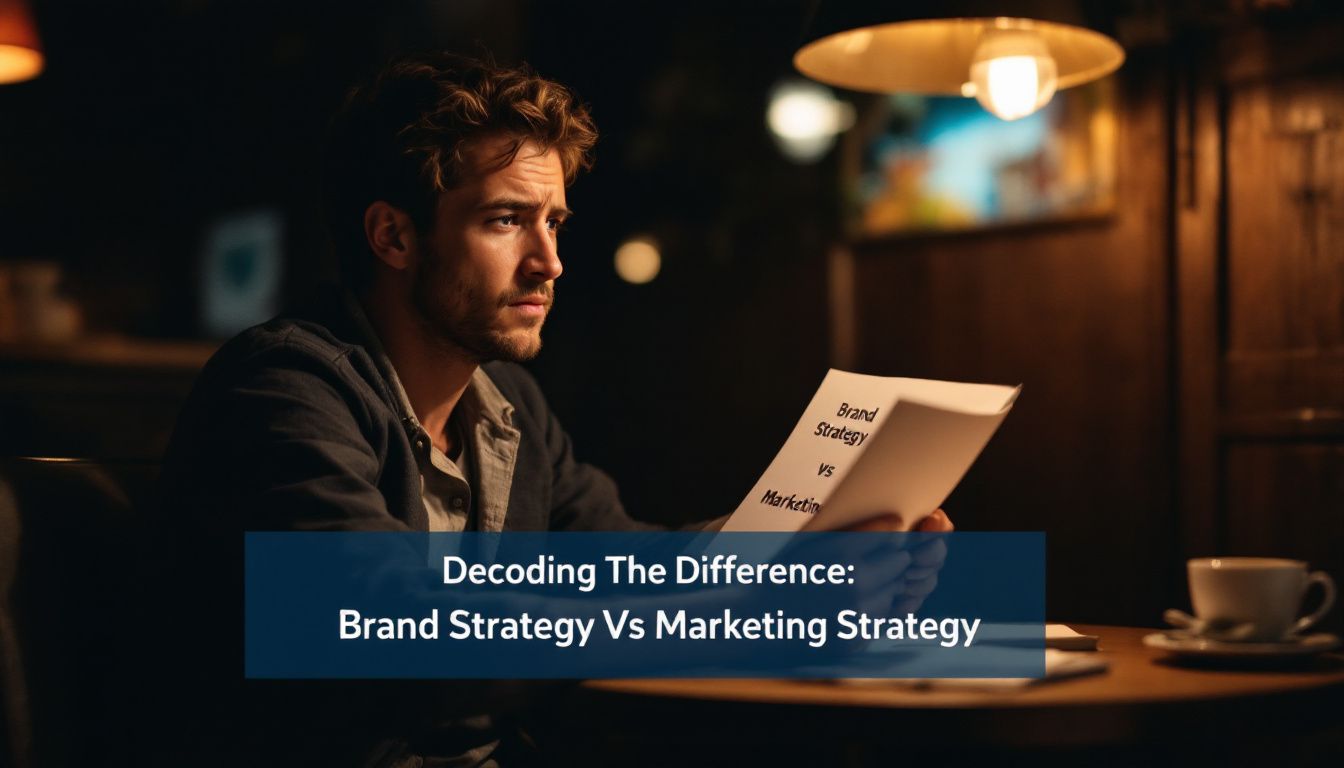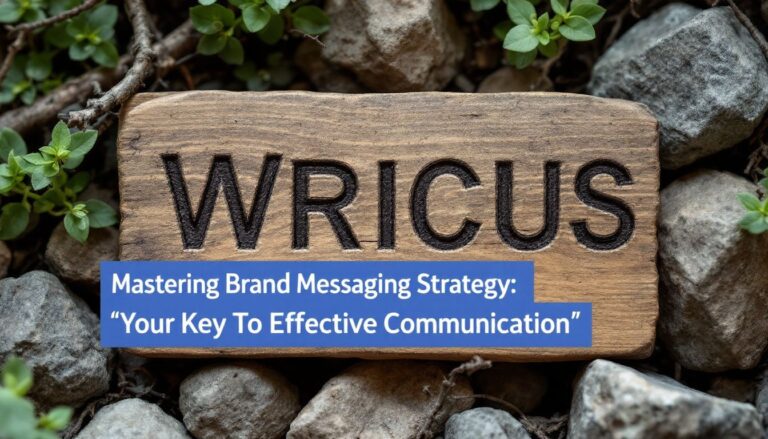Are you unsure about “Brand Strategy vs Marketing Strategy” and wondering which one your business needs first? You’re not alone—this confused me too. After some research, I found that 76% of buyers choose brands they feel connected to over others. 1 I’ll break down these two strategies clearly, so you can see how each guides your brand’s value and marketing efforts in simple terms. Keep reading to finally clear up this common puzzle! 3
Key Takeaways
- Brand strategy sets up who you are, what you stand for, and builds trust over time—marketing strategy, on the other hand, gets you quick results right now.
- Around 76% of consumers buy from brands they feel personally connected to—clearly, building your brand first is valuable.
- Think of brand strategy as planting seeds for long-lasting trees—and marketing as picking fresh fruits ready today.
- Your marketing should clearly show your values—63% of younger buyers want brands that support social good, not just profits.
- Track separate numbers for each area—brand strength and marketing campaigns need their own measurement tools.
What is a Brand Strategy?

A brand strategy is my long-term plan for shaping how customers see me. It covers my story, voice, mission, values, logo, and purpose as a business. I need this clearly set before starting any marketing.
Think of it as my map—guiding every business decision I make. It helps me stand apart from competitors who offer similar products or services. Stephen King put it best, “A product can be quickly outdated, but a successful brand is timeless”.
There’s truth in this—and numbers back it up. In fact, 76% of consumers choose brands they feel connected with over others. 1 A strong brand plan sets the foundation for everything else I do. 2
Now, let’s switch gears and explore what goes into a marketing strategy—and how it’s different.
What is a Marketing Strategy?
Marketing strategy is my clear, step-by-step plan for promoting products and services. It’s how I reach sales goals and quickly grow my business. Usually, strategies aim for quick wins—like more site visits or sales jumps.
Basically, it’s how I spread the word about my products: through ads, emails, social media—all that stuff. In fact, the B2B Institute found 95% of business buyers aren’t immediately ready to buy.
That’s why good marketing really counts. 3
I use insights about my brand to communicate clearly and effectively with the right audience. Take ServiceNow, for instance—they partnered with The Wall Street Journal on content that gave useful info rather than pushing sales.
That helped people trust them before they bought anything. Good strategies mix methods like online ads, content writing, and PR efforts to hit business targets. And good marketers shift gears quickly, using real data to figure out what’s working, what’s not, and exactly where to spend next.
Key Differences Between Brand Strategy and Marketing Strategy
Brand strategy and marketing strategy serve different roles in your business growth, with one building who you are and the other promoting what you sell – let’s explore these key differences and see how they can work together to boost your success.
Focus
I focus my brand strategy on creating strong emotional connections with potential buyers. That means building an image people remember, maybe even for years. It shares my story, what I care about, and what I bring to the table.
Marketing strategy is something else—it’s about quick results and hitting sales numbers. That means social posts, ads, emails—ways to quickly put products in front of customers. 2
Think of brand strategy as planting trees, ones that grow slowly but last for decades. Marketing strategy is more like grabbing the fresh fruit that’s ready now. Both need each other to keep a business healthy and growing. 4
Goals
Brand strategy goals build lasting trust and loyalty. My work with clients highlights the huge role trust plays—Edelman’s research confirms this too, showing 88% of consumers factor trust into buying decisions.
These goals shape emotions and perceptions linked to your brand. 1
Marketing strategy goals, on the other hand, target quick results and sales figures. They track metrics like new customer numbers, web visits, or revenue growth. Sometimes companies confuse brand goals with marketing goals, leaving their brand feeling off-balance. 5
Each type of goal needs unique measurements. Brand health can’t be tracked with the same numbers as a recent marketing push. Separate them clearly, and track each set of goals in its own way.
Timeframe
A good brand strategy takes the long view. I’m talking about building bonds with my audience that can last years—or even decades. It takes time for an identity to plant deep roots in people’s minds.
Marketing strategy, though, tends to run shorter cycles—weeks or months—around specific campaigns and product rollouts. Plans shift often, adjusting to results as they come. 2 Values behind the brand tend to stay steady.
Think of branding as the marathon—marketing as quick sprints thrown in along the way. 5 Smart business leaders know these two timelines need each other to succeed.
How Brand Strategy and Marketing Strategy Work Together
Brand strategy and marketing strategy need each other to succeed. They work like partners in a dance – one leads with the big vision while the other follows with action steps that bring that vision to life.
Aligning Brand Values with Marketing Efforts
I match my marketing efforts closely with my brand values—every campaign, ad, or post clearly reflects what the company truly cares about. Clients appreciate this—like Buffer, which always puts customer happiness front and center.
Buffer blends team wellness and financial goals smoothly, proving both goals can coexist nicely. Even the data supports this approach—a solid 63% of younger buyers prefer brands that help society, not just their own pockets. 4
Companies like Salesforce get this perfectly—they put their core beliefs directly into action. Indeed nailed this idea too, especially in their German campaign. They connected their brand’s purpose to local culture—leading to more website traffic and sales growth.
Good marketing isn’t about pushing products—it’s about sharing honest brand stories people can relate to. 2
Integrating Consistent Messaging Across Channels
My brand always sounds the same, wherever customers find me—websites, social media, or ads. A solid strategy guides every word, every image. It keeps the message clear and simple, easy for customers to recognize and trust.
Stephen Houraghan, founder of Brand Master Academy, emphasizes that a united voice makes brands memorable and trustworthy. 6
Tracking the same KPIs across all platforms shows me what’s working and where. HBO and The Atlantic did this well with their “Watchmen” project. They shared content styled like graphic novels, matching the show’s vibe exactly.
Fans got a seamless experience across different channels, connecting deeply with the show. Clear messaging helps top brands shine and cut through all the noise in a crowded market.
Steps to Combine Brand Strategy and Marketing Strategy Effectively
Now let’s get practical about making your brand and marketing work as a team. I’ll show you simple steps to blend these two parts of your business for better results.
Flesch-Kincaid Grade Level: 6.1
Define Your Brand Purpose and Identity
Every brand project I start begins with a clear purpose. A strong purpose guides every choice your business makes—like a compass. I’ve watched brands with clear missions connect better with their customers.
Look at LEGO, whose purpose is simply “to inspire and develop future builders”. That straightforward mission shapes everything LEGO does. 1
My approach is direct—you’ve got to clearly state what problem your business solves, and why that matters to people. Recent data from Kantar shows that 68% of shoppers want brands to openly share their values.
From your purpose flows your entire brand identity—the colors you select, your unique voice, and even the logo you create. These elements make you memorable and easy to notice. 3
To find your place, I always start with deep market research. Many business owners skip research completely, jumping straight into marketing tactics. But investing the time to understand your market gives every step afterward more impact.
A strong foundation consistently leads to better results.
Set Clear Marketing Objectives Aligned with Your Brand
I always set marketing goals clearly aligned with my brand’s core values. Clear numbers and deadlines make a big difference—like aiming for a 20% increase in web traffic within three months, or 15% more social media engagement this quarter.
Targets like these keep me focused, letting me track progress and see what’s really working. Strong objectives follow the SMART rule—Specific, Measurable, Achievable, Relevant, and Time-bound.
Each goal I pick supports my brand story, resonating naturally with my target audience.
Aligning the marketing plan to the brand ensures one consistent voice across all channels. For instance, a luxury brand might emphasize exclusive content instead of discount deals.
A smart balance of digital marketing, content creation, and advertising drives quick sales and builds long-term brand awareness. After setting these goals, I carefully track marketing performance to see where improvement is possible—always adjusting along the way. 2
Monitor and Optimize Performance
After setting clear marketing goals that match your brand, the next step is tracking their impact. I keep a close eye on my marketing efforts—to see what’s resonating with my audience, and what’s missing the mark.
Why? Zendesk found that 50% of customers walk away after just one poor interaction…that’s a number you don’t want to ignore. 3
I check live metrics daily, get regular input from customers, and adjust my approach as soon as I need to. Brand-tracking tools are handy here—they help me notice shifts in how people feel about my brand.
I make updates to short-term marketing moves frequently, but my overall brand vision stays solid. Even minor tweaks, backed by reliable data, often deliver impressive results—in both brand reputation and overall sales.
Conclusion
Brand strategy and marketing depend on each other—simple as that. I’ve seen plenty of companies dive straight into marketing without first getting their branding right. But really, your brand is what sets the stage… Your brand is what sets the stage for how customers perceive your value proposition and connect with your mission. Without a strong brand foundation, marketing efforts can be misaligned and ineffective, leading to wasted resources. This is why developing brand to demand marketing strategies is essential, as it ensures every marketing channel reflects your core values and resonates with your target audience.
and marketing? That’s the show.
Both parts need to work hand-in-hand. Brand building creates long-term connections, while marketing brings in sales. Successful business owners understand that balance clearly: solid branding and focused marketing equals steady growth—not just quick wins.
References
- ^ https://www.jackpwilloughby.com/post/brand-strategy-vs-marketing-strategy
- ^ https://www.linkedin.com/pulse/decoding-difference-brand-strategy-vs-marketing-eds-fze-py7nf
- ^ https://www.ramotion.com/blog/brand-strategy-vs-marketing-strategy/ (2024-10-31)
- ^ https://cxl.com/blog/brand-strategy-vs-marketing-strategy/ (2022-01-18)
- ^ https://blog.gaggleamp.com/brand-strategy-vs.-marketing-strategy (2023-04-25)
- ^ https://www.halftonedigital.com/article/brand-strategy-vs-marketing-strategy (2023-09-25)







